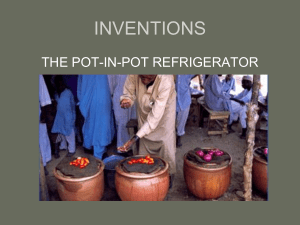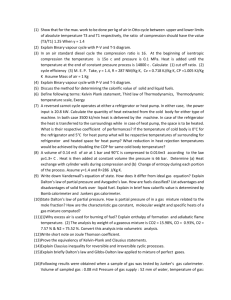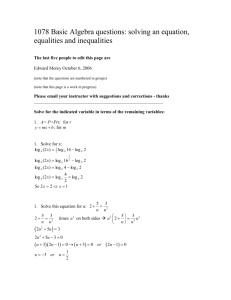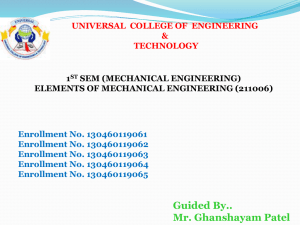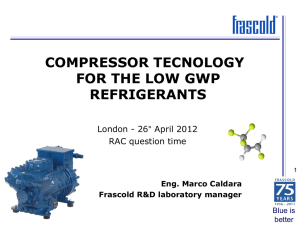Domestic refrigerators with cooling of compressor: A Review
advertisement
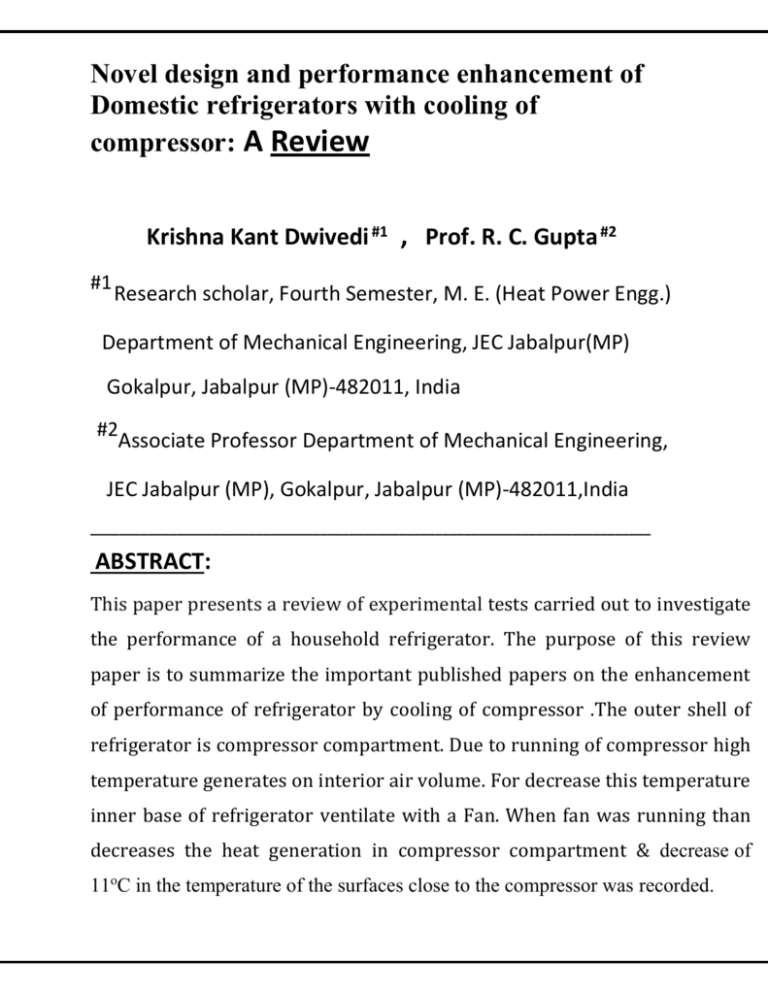
Novel design and performance enhancement of Domestic refrigerators with cooling of compressor: A Review Krishna Kant Dwivedi #1 , Prof. R. C. Gupta #2 #1 Research scholar, Fourth Semester, M. E. (Heat Power Engg.) Department of Mechanical Engineering, JEC Jabalpur(MP) Gokalpur, Jabalpur (MP)-482011, India #2 Associate Professor Department of Mechanical Engineering, JEC Jabalpur (MP), Gokalpur, Jabalpur (MP)-482011,India ______________________________________________________________________________ ABSTRACT: This paper presents a review of experimental tests carried out to investigate the performance of a household refrigerator. The purpose of this review paper is to summarize the important published papers on the enhancement of performance of refrigerator by cooling of compressor .The outer shell of refrigerator is compressor compartment. Due to running of compressor high temperature generates on interior air volume. For decrease this temperature inner base of refrigerator ventilate with a Fan. When fan was running than decreases the heat generation in compressor compartment & decrease of 11oC in the temperature of the surfaces close to the compressor was recorded. Hence there are lower CO2 emissions to the environment & make more efficient. KEYWORDS: Refrigerator, Compressor, Fan, Surface ventilate, energy efficiency. ______________________________________________________________________________ INTRODUCTION: Domestic refrigerators are identified as major energy consuming domestic appliances in every household. In France refrigerators consume about 26% of the residential electricity demand and they are estimated to be responsible for 17% of the overall greenhouse gas emission in the country. The compressor is responsible for more than 80% of the total energy consumed by the refrigerator increasing the energy efficiency of this device is thus an important issue in terms of energy savings. In almost all domestic refrigerators all components are assembled in the same relative position since several years ago. It is also known that the condenser releases heat at high temperatures (first law of thermodynamics) as well as the compressor. This heat is rejected to the environment in almost all practical situations partially by natural air convection. However, part of it is due to thermal radiation that causes an overheating of the refrigerator surfaces adjacent to those equipments. As a consequence there are more heat gains to the refrigerator through these surfaces and hence higher air temperatures inside it. Compressor manufacturer datasheets provide information on compressor performance under conditions. A condensing temperature of 54.4°C, and ambient, liquid and suction gas temperatures of 10 32.2°C. These operating conditions are quite different from those obtained when the compressor is part of a 11 domestic refrigeration system. Therefore, compressor performance under ASHRAE conditions may not 12 reflect how well compressors will perform under more realistic conditions e.g. at ambient conditions 13 normally found in domestic refrigeration. For example, the annual average room temperature is well below 14 32°C and the suction temperature during typical operation of a refrigerator is normally much lower than 15 32°C. At lower ambient temperatures the compressor COP is higher as the pressure ratio will decrease due to 16 a lower condensing temperature. Previous studies have shown that one of the critical zones of the outer shell of a refrigerator is located around the compressor, with higher temperatures when compared with other external surfaces. This is due to the amount of heat transferred from the compressor surface to the surrounding air, while it is running. In spite of the thermal insulation zone surrounding it, a substantial portion of the heat generated during the operation of the compressor is transferred to the interior air volume of the refrigerator, with negative consequences for the entire system. As a consequence, the compressor running time is higher than it should be without this heat input, which implies higher energy consumption and, consequently, higher CO2 emissions to the environment. LITERATURE REVIEW: The following literature review describes important research results regarding the cooling of compressor in household refrigerator. R. Radermacher, K. Kim (1996)- This work gives the recent development of Domestic refrigerator. In this paper study the cooling performance of compressor of a household refrigerator and by using the mixed refrigerant in domestic refrigerator, we were observed the freezer temperature lower than that of the R134a. [1]. Clito Afonso, Joaquim Matos. (2006) - study The effect of radiation shields around the air condenser and compressor of a refrigerator on the Temperature distribution inside it. In this work it was shown that with minor modifications in the available commercial refrigerator. it is possible to have a decrease in the inside air temperatures. These modifications simply consist in covering the external rear wall of the refrigerator and the compressor recess wall with a sheet of aluminum foil avoiding in that way the radiation heat transfer from the condenser and the compressor to the external surfaces of the refrigerator. [2] Moo-Yeon Lee, Dong-Yeon Lee, Yongchan Kim(2007)- in this work study The performance of the small-capacity directly cooled refrigerator. The compressor displacement volume of the alternative system with R290/R600a (55/45) was modified from that of the original system with R134a to match the refrigeration capacity. The capillary tube lengths for each evaporator in the optimized R290/R600a system were 500mm longer than those in the optimized R134a system. The power consumption of the optimized R134a system was 12.3% higher than that of the optimized R290/R600a system. The cooling speed of the optimized R290/R600a system at the incase setting temperatures of 150 C was improved by 28.8% over that of the optimized R134a system because of the slightly higher operating pressure and relatively high heat Transfer performance of R290/R600a (55/45). [3] Diegues, M., Freitas, B. (2008)- Investigated the Thermal Studies of Household Refrigerators with Compressor Cooling by using the mixed refrigerant in domestic refrigerator, we were observed the freezer temperature lower than that of the R134a. [4] K. AzzouzD. Leducq, D. Gobin (2009)- This work investigated the experimental tests carriedout to investigate the performance Of a household refrigerator using a phase change material (PCM). The experimental study of a household refrigerator equipped with a latent storage unit on the unused face of the evaporator shows an enhancement of the system performance and a reduction of the temperature fluctuations in the refrigerated cell. [5] C. Conceição António,C.F. Afonso (2010)- in this paper evaluate the In refrigerated spaces, the inside air is cooled by a heat sink operating either by forced or natural convection. This work studies temperatures in a commercial household refrigerator that were monitored with thermocouples located at several points. The measured temperatures were then compared with those obtained from two different simulation tools. In all refrigerated spaces, it is important to understand the inside Air temperature distribution to know the best places to locate products due according to their specific characteristics. [6] Yicai LiuKai Chen, Tianlong Xin, Lihong Cao(2011)- This paper has examined the application of prototype diffuser pipes in a refrigeration system. The refrigerator with diffuser pipe was constructed in this study and then compared with a refrigerator without an exhaust/suction-pressurized and energy-saving diffuser pipe.Two kinds of diffuser pipes have been used: exhaust and suction-pressurized and energy-saving diffuser pipe. The diffuser pipes have been installed behind the exhaust port and in front of the suction port. The experimental data were presented supports the theoretical findings. This novel refrigeration system is more reliable and has higher COP, and lower energy costs, making it more attractive than conventional ejector refrigeration cycles. [7] Jong Kwon Kim, Chul Gi Roh, Hyun Kim (2011)- In this work, an inherent capacity modulated linear compressor for a refrigeration application is investigated through numerical simulations and experiments. This work starts from the variable stroke mechanism, a free piston system, which makes it possible to produce a novel design for an inherent capacity modulated linear compressor. A prototype of an inherent capacity modulated linear compressor that produces capacity according to the cooling demand of a household refrigerator was developed through a numerical approach. [8] Clito F. Afonso (2012)- experimentally investigated on the behavior and heat transfer enhancement of the outer shell of household refrigerators is the compressor Compartment. This work presents a modification that was carried out in a commercial household refrigerator, in order to improve its efficiency. [9] N.Austin, Dr.P.Senthil Kumar, N.Kanthavelkumaran (2012)invested an ozone friendly, energy efficient, user friendly, safe and costeffective alternative refrigerant for HFC134a in domestic refrigeration systems. This experimental investigation carried out to determine the performance of a domestic refrigerator when a propane/butane mixture is used as a possible replacement to the traditional refrigerant R134a. The system was evacuated with the help of vacuum pump to remove the moisture and charged with the help of charging system. The temperature inside the chamber was maintained at 25°C and 28°C. When the temperature and humidity inside the chamber was at steady state, the experiments were started. The experiment has been conducted on the domestic refrigerator at no load and closed door conditions. [10] All the Literature Review are summarized in table-1 given below as S.No. AUTHERS Title Description Medium Of Cooling Of Compressor Description Of Experimental Setup 01 Clito Afonso, Joaquim Matos. (2006) The effect of radiation shields on compressor Decrease in the inside air temperatures. covering the external rear wall The freezer works with a standard vapor compression cycle with 0.13 kg of R-134a as a refrigerant. The double door refrigerator was monitored. 02 Clito F. Afonso (2012) Heat transfer enhancement of the outer shell of household refrigerators Compressor cooling by forced air ventilation. The ventilation system (plenum and fan) was designed to ensure a continuous air flow through the outer surface of the compressor. 03 Diegues, M., Freitas, B. (2008)- with Compressor Cooling by using the mixed refrigerant in domestic refrigerator By mixing of different refrigerant. Household refrigerator tested with different Mixed refrigerant. K. AzzouzD. Leducq, D. Gobin (2009)- Experimental tests carried out to investigate the performance Of a household refrigerator By using phase change material(PCM) Household refrigerator covered with phase Change material. Yicai LiuKai Chen, Tianlong Xin, Lihong Cao(2011)- Enhancement efficiency by using prototype diffuser pipes in a refrigeration system. By using diffuser pipe. Household refrigerator connected with two Types of diffuser pipes. Exhaust port and in N.Austin, Dr.P.Senthil Kumar, N.Kanthavelkum aran (2012)- By using costeffective alternative refrigerant for HFC134a in domestic refrigeration systems By using HFC 134a 05 06 Suction port. Refrigerator works with HFC 134a Refrigerant. CONCLUSIONS: 1. The advantages of using SUNISO 3GS mineral oil as the lubricant instead of POE oil in a household refrigerator with water-cooled condenser was investigated experimentally the energy consumption of the HFC134a refrigerator using SUNISO 3GS mineral oil as the lubricant reduced the energy consumption of the household refrigerator between 8% and 11% for different loads. [3] 2. In this work it was shown that with minor modification in the available commercial refrigerator. It is possible to have a decrease in the inside air temperatures. [1] 3. This work presents a modification that was carried out on a commercial refrigerator, in order to improve its efficiency. This leads to a direct decrease of CO2 emissions to the environment which varies from country to country due to their different electricity generation mix. [2] 4. This work has examined the application of prototype diffuser pipes in a refrigeration system. Two kinds of diffuser pipes have been used: exhaust and suction-pressurized and energy-saving diffuser pipe. The diffuser pipes have been installed behind the exhaust port and in front of the suction port. [5] 5. This work starts from the variable stroke mechanism, a free piston system, which makes it possible to produce a novel design for an inherent capacity modulated linear compressor. [9] 6. The experimental study of a household refrigerator equipped with a latent storage unit by using PCM(phase change material). [4] 7. This project invested an ozone friendly, energy efficient, user friendly, safe and cost-effective alternative refrigerant for HFC134a in domestic refrigeration systems. [7]. REFERENCES: [1]. Clito Afonso, Joaquim Matos. (2006) , Faculty of engineering da University Porto, R. Dr. Roberto Frias, 4200 465- Porto, Portugal. [2].. Clito F. Afonso Department of Mechanical Engineering, Faculty of Engineering, Porto University - FEUP, Rua Dr. Roberto Frias, 4200-465 Porto, Portugal. [3].. Diegues, M., Freitas, B. (2008), International Journal of Refrigeration 31 (2008) 510e515. Experimental investigation on R134a vapor ejector Refrigeration system, International Journal of Refrigeration 29 (2008) 1160e1166. [4]. K. AzzouzD. Leducq, D. Gobin (2009), Cemagref: Refrigerating Processes Unit, Parc de Tourvoie BP 44, 92163 Antony Cedex, France, 502, Campus Universities, 91405 Orsay, France. [5]. v. Yicai Liu, Kai Chen, Tianlong Xin, Lihong Cao, Siming Chen, Lixin Chen, Weiwu Ma School of Energy Science and Engineering, Central South University, Changsha 410083, China. [6]. N.Austin1, Dr.P.Senthil Kumar2, N.Kanthavelkumaran3 1Research Scholar, Sathyabama University, Chennai, Dist – 629203. [7].. R. Radermacher and K. Kim, Center for Environmental Energy Engineering, University of Maryland, College Park, MD 20742, USA. [8]. Jong Kwon Kim , Chul Gi Roh , Hyun Kim, Home Appliance Research Lab., LG Electronics, Gasan-dong, Geumcheon-gu, Seoul 153-802, Republic of Korea. [9]. Moo-Yeon Leea, Dong-Yeon Leeb, Yongchan Kima, Department of Mechanical Engineering, Korea University, Anam-Dong, Sungbuk-Gu, Seoul 136-713, Republic of Korea. [10]. Massey, B., 1976. Mechanics of Fluids. Van Nostrand Reinhold. Warhaft, Z., 1997. An Introduction to Thermal-fluid Engineering. Cambridge University. [11]. Dinc¸ er, I., 2003. Refrigeration Systems and Applications. John Wiley & Sons, England.. [12]. J.Fearon, Expansion devices, Journal of Refrigeration and Air Conditioning (July 1979). [13]. R. Saffa, F.A.A. Clito, C.O. Armando, D.A.R. David, Natural refrigerants for refrigeration and air conditioning systems, Applied Thermal Engineering 17 (1997). [14]. Chun, T.W., Ahn, J.R., 2008. A novel strategy of efficiency control For a linear compressor system driven by a PWM inverter. IEEE transaction on industrial electronics 55, 296e301. [15]. Unger, R.Z., Walt, N.R., 1994. Linear compressor. Int. Appl. Tech. Conf. [16]. Bjork, E., Palm, B., 2006. Refrigerant mass charge distribution in a domestic refrigerator, part I: transient conditions. Appl. Therm. Eng. 26, 829837. [17]. James, R., Marshall, S., 1973. Dynamic analysis of a refrigeration system. In: Proceedings of the Institute of Refrigeration, pp .13–24. [18]. I.W. Eames, A.E. Ablwaifa, V. Petrenko, Results of an experimental study of an advanced jet-pump refrigerator operating with R245a, Applied Thermal Engineering 27 (2007).

